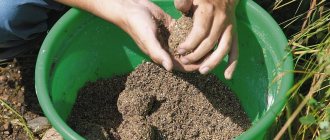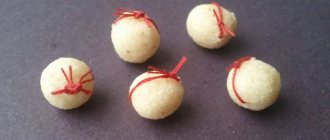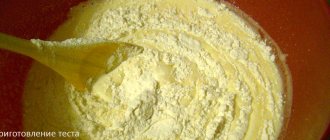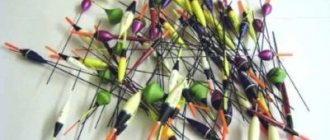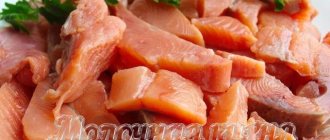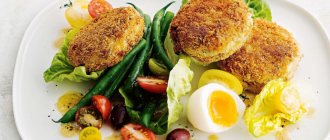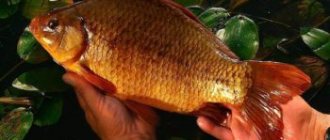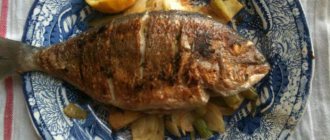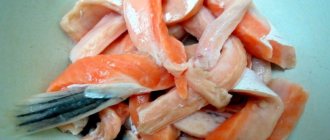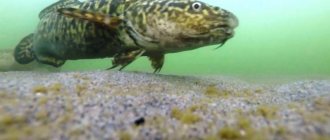The main types of semolina bait are the same for all amateurs; only the substances added to the finished mixture that especially attract fish differ.
Types of semolina attachments
During the use of semolina in fishing for crucian carp and other peaceful fish species, several basic forms were invented :
- semolina mash;
- dough: it is prepared in several ways;
- boiled “cool” semolina.
Each variety has its own adherents and certain periods of greatest popularity among crucian carp.
As one of the main components, semolina is used to make pea mash, especially when using pea flour or beans ground in a coffee grinder. In this case, these two ingredients are used in equal quantities.
Where and when is the best time to catch crucian carp using semolina?
When going fishing on an unknown lake or river, you should prepare a full set of baits for crucian carp. The best time to use semolina is with warm water. In spring, summer, and early autumn, semolina porridge is one of the best baits for crucian carp and white fish. But the presence of catchable baits cannot always ensure a good catch.
Optimal results at this time can be ensured by good complementary feeding and choice of fishing location. Any watercraft will provide the greatest convenience. Using a boat, you can get to your favorite fish habitats. And a short cast into a window between snags or river vegetation is easier to do.
Important! Overgrown places with aquatic vegetation are favorite feeding and resting places for fish. In these areas the water warms up well. And in summer, in shaded places, with snags or overhanging tree branches, crucian carp find coolness.
These are the very first places where complementary foods should be introduced.
In spring, it should be caught in areas with a depth of up to 2 m. If you go to a studied reservoir, remember that this is a sedentary fish that constantly feeds in certain places. Therefore, after fishing you should not take away the remaining complementary food. The fed fish will constantly return to its dining room.
A good way to visually determine the location of crucian carp is by rising air bubbles and moving reeds or reeds . This means that the fish have come out to feed and reproduce.
How to properly prepare semolina (recipe)
Before making the bait, you will need to do some preparatory work.
We will need:
- container for soaking cereals;
- water from the river;
- spoon or stick for stirring the mixture;
- semolina.
It is better to use water from a reservoir. Smelly tap water can scare away wary fish.
Having prepared all the ingredients, you can begin making bait. Pour 2-3 tablespoons of cereal with water. Here you should ensure that the water fills the entire semolina 5 mm above. Cover and set the container aside for an hour. During this time, the semolina will swell.
The mass is ready for further action. Now stir the mixture with a spoon or any stick. This operation will take at least 30 minutes; when ready, the mash begins to reach for the spoon at a distance of several centimeters and does not come off.
All that remains is to prepare and transfer the finished bait into a medical syringe, baby pacifier or other storage container. A syringe or nipple allows you to place the bait by gradually squeezing it out and twisting it around the hook. If the mash is placed in a box, you can twist it using a thick blade of grass or wood chips.
The consistency of the bait will have an elastic, not very soft structure. You should not allow the formation of a very hard, crusty mush. This bait can only be used as complementary food.
Recipe for semolina dough with garlic
When the water temperature is insufficient, especially in early spring or late autumn, semolina can become a desirable bait for crucian carp, but with the addition of garlic as a flavoring agent . Many fishermen use only fresh garlic cloves; some prefer a dried or powdered mixture. It is important not to overdo it when applying - in this case, the fish will be wary of the bait.
Important! If crucian carp bite on one bait for a long time, you should replace the bait on other fishing rods. This is the best option for today's fishing.
To prepare garlic bait you will need:
- sufficient amount of wheat flour;
- semolina;
- sunflower or corn oil;
- fresh or freeze-dried garlic.
Mix wheat flour and semolina in a ratio of 1/3. Fill with water and stir. Please note: the water is not poured in full; it is better to add it in doses so that you do not have to add semolina or flour. Let the dough sit a little and add sunflower oil.
You can use any vegetable oil, but crucian carp prefer sunflower or corn oil. After pouring a little oil on your hands, we begin to knead the mixture. A well-prepared mixture begins to smell like roasted seeds. All that remains is to add the garlic pulp and knead the dough again.
To prepare the flavoring, we experimentally select a sufficient amount of garlic, then pass it through a meat grinder or grate it. The main thing is not to overdo it if there is not enough seasoning. It can be added during fishing.
All types of carp and peaceful fish love to eat semolina with garlic in cool water.
Mastyrki
When fishing for crucian carp in the summer, mastyrkas are widely used. All of them are made on the basis of semolina with the addition of peas or corn . Their consistency is similar to thick dough with a pronounced smell of the additive used. A wide range of similar baits are sold in fishing stores. The most widely used when fishing for crucian carp is pea-based mastyrka. In this article we will look at a simple way to prepare it at home.
Method 1:
- First you need to prepare the pea puree. Take 200 grams of product. To speed up the process, it is advisable to soak peas (green or yellow), or chop them by passing them through a meat grinder several times or grind them in a blender.
- Place the peas in a saucepan and fill with cold water so that it covers the cereal by 2 cm. The puree is simmered over low heat until cooked and stirred constantly. If the water has boiled away and the peas are not ready, you need to add it. Do not allow it to burn under any circumstances - you will have to do it again, since such a base will not work. The finished puree should resemble thick jelly.
- Turn off the heat and add 1-2 teaspoons of aromatic sunflower or hemp oil to the mixture.
- Constantly stirring the pea puree, pour in 200-250 grams of semolina. Remember, the less semolina, the more tender the mastyrka will be, but it will be washed off the hook faster.
- Place the cooled mass on the table and knead thoroughly. You can sprinkle the surface with semolina or flour. The finished mastyrka should not stick to your hands.
Method 2:
Suitable for preparing mastyrka in natural conditions. To prepare it you need:
- Grind the peas in a coffee grinder to a powder. Green and split peas are better options.
- Before leaving for fishing, boil water and pour it into a thermos.
- Directly on the pond, pour the pea powder into the prepared bowl, pour boiling water over it and cover with a lid for 2-3 minutes.
- While stirring the puree, add butter and semolina. We select the proportions the same as in the first method.
A video demonstrating the preparation of pea mastyrka, which crucian carp are crazy about. Beautiful, interesting and very useful video!
Raw baits, chatterbox
Raw baits (often called “chatterboxes”) from semolina can be prepared at home just before going fishing or directly on the pond. They are prepared for one fishing trip, so 200 grams of ready-made bait will be enough for one fisherman.
Coarse grains are better suited for making “chatter,” so the semolina must be sifted. There are several ways to prepare raw baits.
Method 1:
- To prepare the traditional “chatter”, pour the prepared semolina into the bowl to about three-quarters of the volume.
- Gradually add cold water, constantly stirring the semolina. You can use water from a pond or prepare it in advance (carbonated and chlorinated water is not suitable). Do not use warm water - the prepared “chatter” will quickly be washed off in the water. The semolina should be completely wet, do not leave any dry lumps.
- Drain off excess water until it covers the cereal by a few millimeters.
- After 30-40 minutes, when the semolina swells, knead it until smooth. The prepared “chatterbox” should stretch behind the stick to the length of a matchbox and stick well to the hook.
- Spread the mixture using a small clean stick. At the same time, we hold the hook with one hand, and with the other we wrap the “talker” around the sting several times. The result should be a ball of the required size. Instead of a stick, you can use a large-volume medical syringe. To do this, fill the syringe with the prepared mixture and screw the semolina onto the sting, gradually squeezing it out.
Method 2:
It can only be used on a pond:
- Take a large piece of gauze. Fold it in four.
- Pour out the prepared semolina and tie a knot tightly.
- Rinse it in a pond to remove small particles. The result is a dense, elastic mass, ready to be attached to the hook.
Below is a wonderful video demonstrating the operation of the catch bait - raw dough and the method of preparing it.
Method of attaching semolina to a hook
You can store and bait the chatterbox from a closed container, but if the weather is not hot and dry, you can store the bait in an open form. In this case, we pick up semolina with any stick or hard blade of grass and wind it around the hook. But it is better to preserve and bait the chatterbox and soft dough using a syringe or a baby pacifier.
If you use a syringe, press the plunger and a thin strip of bait comes through the hole. We wrap it around the hook tip and make a ball of sufficient size. Semolina is attached in the same way using a baby pacifier.
This storage method allows you to protect the finished mixture from exposure to temperature or moisture. Moisture is more dangerous for chatterbox, and it can become moldy. Many anglers use toothpaste tubes to store and use them. To do this, it is unwound from the blind edge, opened and washed well. Then they put the bait in it and twist the back part again.
In cold weather, the container should be placed in the inner pocket of your clothing. In this case, the bait will not lose its elasticity.
Important! To catch fish using talkers and dough, special hooks with a wound spring are produced. This method allows you to more firmly attach the bait to the hook. Remember the size of the bait ball. If you make the ball large, empty bites of small things that cannot swallow the bait will make fishing, perhaps exciting, but certainly ineffective.
Bait for crucian carp video
By watching the video, you can learn much more interesting information than by reading. The preparation of any dough or bait has its own subtleties, which are often not written about, but are told and shown in videos. Therefore, watching a video allows you to get better information. As a rule, experienced fishermen quite often use secret ingredients that improve the overall characteristics of baits or dough. Very often they share their achievements with other anglers, especially beginners. Therefore, any information will never be superfluous, especially that which is present in this video.
Semolina dough for catching crucian carp
Fishermen consider dough to be one of the most common semolina baits for catching crucian carp. It is made according to several recipes, each fisherman has his own, treasured one. Let's look at the most common ones in more detail.
How to make a bait from “cool” semolina?
This type of bait can be used when catching crucian carp and all types of white fish using a spinning rod, donka and all types of float rods. It is better to store the bait in a bag or other closed container. To make hard boiled dough, it is recommended to do the work in 2 main ways:
- In the first option, work is carried out as follows:
- we prepare the same amount of semolina and water for work;
- pour the water into a container and bring to a boil over low heat;
- add semolina, stir the mixture constantly to prevent lumps;
- after obtaining a homogeneous mass, remove from heat and wrap in warm clothes for steaming;
- an hour after the semolina has swollen and cooled slightly, it must be kneaded like dough - work is carried out until the bait is given a sufficient level of elasticity and density;
- Now all that remains is to add the flavorings and place them in different, always clean, containers; We put the rest in the refrigerator.
- The second method involves making bait in this way:
- pour 200 g of semolina into a container and fill it with purified water;
Important! When making any types of dough baits, you should not use tap water. In some places it not only stinks of bleach, but also of iodine and other substances. You can bring water from the river or use purified water.
- Having mixed the mixture well, put it in thick cloth or gauze;
- fold and tie the corners of the fabric;
- Wring out the resulting bag well and place it in a pan of boiling water;
- after 30 minutes, wrap the finished semolina and let it cool gradually;
- We collect the bait from the walls of the bag, add flavors and attractants and store it in the refrigerator.
Regardless of the preparation method, the finished bait can be cut into small pieces and then rolled into balls for bait; small pieces can be separated from the whole piece . The main thing is to consider the size of the ball and the fish.
Important! To preserve the bait, you can add flavorings directly while fishing. By applying several variations of your favorite fish smell to individual pieces of dough, you can easily determine the taste preferences of the fish at the moment.
What can you add to semolina dough to increase your catch?
Favorite flavoring additives for crucian carp at different times of the year and day will be several flavor options .
Warm, heated water in a reservoir, in this case crucian carp prefer:
- cinnamon;
- the favorite seasoning for all white fish - anise oil;
- taste of honey;
- garlic;
- sunflower or corn oil;
- chocolate, raspberries, strawberries.
For periods with colder water you will need to add:
- flavoring with the smell of crustacean, shrimp;
- crucian carp taste the smell of crab at this time;
- will be attracted by bait that tastes like bananas;
- apple, peach.
Important! If you add a small amount of oatmeal to the mixture, such bait will arouse the interest of not only crucian carp, but also roach, bream and other peaceful fish.
How to cook semolina for fishing or preparing mastyrka
The advantage of the semolina bait is that it stays perfectly on the hook. By the way, the delicacy can be prepared in different ways and even from different ingredients. As for the latter, it can be peas and semolina.
At the initial stage, the peas are thoroughly washed, which are then sent to a container and filled with water. When all the water has practically boiled away (if there is a lot of it, then simply drain the excess), you will need to gradually start pouring semolina into this mixture. The cereal should be cooked and not form lumps, so stir it constantly until it is completely cooked. When all the ingredients are boiled, remove the delicacy from the stove and cool. The mask should look like plasticine. If everything was done correctly, then the bite will not take long to arrive. Without the required viscosity there will be no sense, so if this happens, add a little semolina or flour.
The presented delicacy is one of the most popular, because the smell of peas is liked by many types of fish. To give the porridge a greater flavor, some people add vanilla sugar or egg yolk to the mixture. It wouldn’t hurt to use different flavors, but there shouldn’t be a lot of them so that the attachment doesn’t start to stink. You can store such a delicacy in the refrigerator, but no more than three days, because then no fish will pay attention to such a dish.
Important! Sometimes the mastyrka dries out, and to give it a “marketable” appearance, you can add a little river water to the mixture.
Methods for storing semolina bait (mash, dough)
When making mash, pay attention to what varieties of wheat it is made from. The best option for fishermen is the soft varieties of this crop. This bait will swell and soak easier. At home, it is stored in the refrigerator, always in a closed container or wrapped in a bag.
Open storage is possible for 2 days. When fishing, the chatterbox will remain for 24 hours if the air temperature is no more than 25 degrees. If the mash is equipped with a flavoring, its shelf life is reduced to 36 hours, but if it is treated with vegetable oils, it lasts for 72 hours.
You can store the dough in the refrigerator for 3 days, but the container must be airtight.
Important! The basic rule for using semolina is that the less semolina is exposed to air and contact with dirty fingers, the longer it will last.
In conclusion, we present several folk, rather extravagant methods for making semolina bait.
We place semolina in a matchbox and immediately add flavorings. We wrap the box with thread to preserve the paper structure and lower it into boiling water. After 60 minutes we get an excellent bait for crucian carp, capable of withstanding fishing in the current.
A rather old but effective method is cooking semolina in a nylon stocking. Having poured semolina, tie it to a water tap and rinse it with water for a long time, constantly grinding the mixture with your hands. This dough has been used for a long time, but the method still works today.
You can increase the life of the bait by adding chicken eggs - 2 pcs., fruit syrup - 50 grams and soy flour: the amount is the same as semolina. After mixing the mixture, divide it into pieces and immerse it in boiling water for several minutes. This bait can be stored in the freezer for a long time. Adding to 2 tbsp. spoons of semolina 2 tbsp. spoons of milk powder, 6 eggs, we get a ready-made bait that works well when adding garlic, pepper or other flavoring in the cold season.
There are many recipes for semolina, each fisherman chooses the most suitable one individually, but knowing a little more information and trying it out while fishing is useful even for professional athletes.
Have fun fishing!
